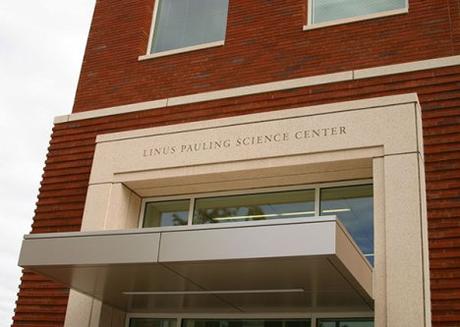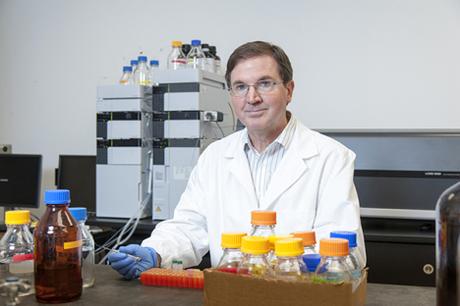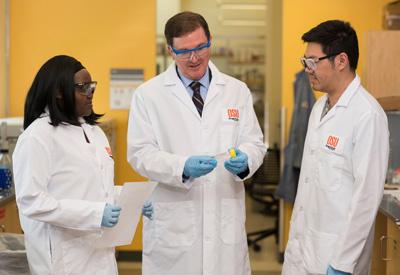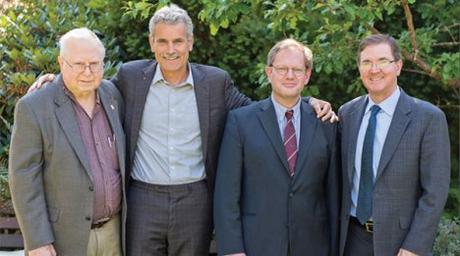
[An interview with LPI director Richard van Breemen, part 3 of 3. This is also our final post for 2018 — see you again in early January!]
Pauling Blog: When did the Linus Pauling Institute become something that was on your radar? Did you have any sense of it in the ’80s and ’90s, or was that far from your world?
Richard van Breemen: I don’t remember for sure, learning about the Linus Pauling Institute, until I visited the campus of Oregon State University. I visited here multiple times over the last twenty years. The very first time was as part of a site visit team for the National Institute of Environmental Health Sciences. They were funding a center here on the Oregon State campus led by George Bailey, who was a member of the Linus Pauling Institute, and Bailey was an expert in toxicology and environmental exposure to toxicants. And he developed a fish model – I think he was working with trout maybe at the time – and that legacy is continuing worldwide and on-campus here at Oregon State, and its led by Robert Tanguay, with the zebra fish model.
At the time we visited here it must’ve been in the 1990s, with George Bailey, and we reviewed his center, and of course it got renewed. And then after he retired – I think he retired from Oregon State around 2008 – it became directed by, for that particular grant, it was taken over by Joe Beckman, who’s also a Linus Pauling Institute investigator to this day. We made one other site visit. Today most NIH institutes have abandoned the site visit approach because of costs, but I’ve found it to be very enlightening. I didn’t know, at that time, much about fish models of toxicology and predicting effects, toxic effects, on animals and human health. But George Bailey was way ahead of his time in that model and it has been adopted, as I’ve said, worldwide.
I came back here to visit a few more times. Next visit would’ve been with the American Society of Pharmacognosy. I’ve mentioned that name before, and that Norm Farnsworth was a famous pharmacognosist; he was one of the founders of that organization. It was actually founded in 1959 in the Pharmacy School at the University of Illinois-Chicago, in the same lecture hall that I’ve lectured in many times. That same building was there in 1959, and that’s where my laboratory had been.
So the American Society of Pharmacognosy has its annual meeting, and it’s held in different places around the country. Oregon State has hosted that meeting at least three times and I’ve attended every one of the more recent ones in the last twenty years here on campus. The most recent one was just a year ago; that was in Portland though. It wasn’t specifically on the Oregon State campus, but several of them were held here, and I did attend one, and it was organized by mainly LPI investigators: Fred Stevens, with help from his colleagues in the LPI like Balz Frei. The next time I visited was at the invitation of Balz Frei, the previous director of the Linus Pauling Institute. He invited me to give a seminar at the LPI. So a few years later, when my telephone rang and my emails lit up with messages: would I be interested in applying to be the director of the Linus Pauling Institute?
So I knew exactly at this point what it was – I was very familiar, I’d been here before, I’d met the people. And it was an easy decision; I submitted my application.
PB: By invitation?
RVB: By invitation.

PB: What are your goals for LPI, now that you are the director, for the next handful of years?
RVB: When I joined the group in Chicago, I was invited and recruited there because I complimented the team. There was a team of experts in pharmacognosy, in biochemistry, in medicinal chemistry, and I brought in certain skills that they didn’t have. But together we were very effective at competing for the National Cancer Institute grants to look for natural products for chemoprevention, the botanical center grant opportunity when that appeared in 1999, and others.
So I want to do all I can to build teamwork. We’ve got a lot of skilled, very talented researchers in the Linus Pauling Institute, but we have no center grants at this time. They have had them in the past, but at the moment there are none. So I’m coming in at sort of a lull and my immediate goal is to put together some teams and compete and hopefully win some external grants from the National Institutes of Health, maybe one from the National Cancer Institute, to look at chemoprevention again, of natural products. The grant I mentioned, that I’ve been a part of in Chicago, is no more. There’ll be a new competition in the next year for the botanical centers program; it would be wonderful if the Linus Pauling Institute could be the home of one of those.
The very next center grant that we will submit will be one that is focused on mass spectrometry, and that one I will submit in the first week of January in the new year, 2019. And the focus of that will be how to rapidly find active – that is, pharmacologically active – natural products and complicated mixtures. This is a question we ask every day in our research with botanical dietary supplements. If the dietary supplement made from a particular plant has an effect on cognition, on blood sugar levels, on estrogen levels and the like, how does it do that? And we can hopefully use mass spectrometry to more rapidly identify the active constituents?
This is something I started doing in Chicago, initially to compliment the field that was combinatorial chemistry. In the late 1990s, the pharmaceutical industry shifted from its more traditional approach to looking to nature to find inspirations to find new therapeutic agents, and they thought, “well, all we have to do is build libraries of chemicals, synthesize all we can, but put them into some storage, and then we screen all those compounds against a target, a pharmacological target, and that’ll be our way of discovering new things.” Some companies built libraries with as many as a million compounds and what they found was that it was very expensive but they didn’t find more compounds and they didn’t develop more drugs than they had before.
So I initially invented some mass spectrometry screening tools so we could look at pools of these combinatorial libraries, and within the pool of a hundred compounds, or five hundred compounds, in one step, identify any that interacted with the pharmacologic target, like an inhibitor of an enzyme. But then I quickly realized that would also be applicable to a plant extract, and if that plant was used by Native Americans, in ayurvedic medicine, in traditional Chinese medicine, for a specific purpose, then it might have a pharmacologic target. And I could take that target and test for compounds that interacted with it to identify them with mass spectrometry in a matter of, let’s say, hours at most, whereas it would take months of an individual’s effort to identify it by the conventional means.
So I want to use that approach, which I’ve been working on for twenty years, and there’s a mechanism at the NIH and the National Institute of General Medical Sciences to get a mass spectrometry center award, to teach other laboratories that do drug discovery and how to do this. Hopefully I’ll have some success, but that’ll involve some folks in the Linus Pauling Institute, like Fred Stevens. We’ll collaborate with the Center for Genome Research and Biology, led by Brett Tyler. That’ll be my first center grant application since arriving here on the Oregon State University campus.
Second will be our botanical center application in the middle of next year. Dave Williams, another LPI investigator, will hopefully submit – and this is something that we’re working on now – he’s putting together a team from the LPI to apply to the National Cancer Institute for funds to study natural products as possible chemoprevention agents. This is what we used to do in Chicago, in a grant that doesn’t exist anymore, and there’s very few research groups left in this country who are doing natural products drug discovery for cancer prevention, so I hope Dave is successful in his NCI application in the new year.
So those are my immediate plans, but it all depends on teamwork, drawing on the experts we have within the LPI, reaching out to other units on campus to build groups who have the breadth and depth of expertise to be competitive for these large grant awards. And, of course, I’m going to continue to do my best to get the word out about the Linus Pauling Institute and continue the philanthropy that Linus Pauling started, which helped build the Linus Pauling Institute in the beginning, as well as the grant proposal approach.

PB: It’s a difficult balance to strike, being an administrator and a scientist at the same time.
RVB: Well, that’s part of the job. I wouldn’t have taken the job if this was going to be a strictly administrative post. I’m not ready to leave the lab, and I also enjoy, very much enjoy, as did Pauling, teaching. I was in a pharmacy school the last twenty-four years and lectured to some pharmacy students, but I spent most of my time training graduate students who either worked in my lab or in other laboratories.
Graduate education is something that we do exceptionally well in the United States; we have a great history of that, from the time our PhD programs were started roughly a hundred years ago. But we rapidly emerged as the world leaders in scientific research and scientific education for researchers. I’ve graduated over fifty PhD student and about twenty-five post-doctoral trainees and master’s students, and I’m continuing that. I brought five graduate students with me from Chicago and I’m looking forward to continuing that tradition. The first grant proposal I submitted once arriving at the Linus Pauling Institute this year was actually a training grant, which will train exclusively pre-doctoral students in natural products research. That’s still pending. I have my hopes up that we’ll get our award before the year is over; the National Institutes of Health training grant.

The four men who have served as director of the Linus Pauling Institute at Oregon State University. From left: Don Reed, Balz Frei, Fred Stevens and Richard van Breemen.
PB: Any thoughts in closing?
RVB: I’m delighted to be here on the campus of Oregon State University. I’d like to say that the moment I heard, my bags were packed, but of course there was the national search, and I interviewed. The process first began on the telephone interview and then an in-person interview and then another follow-up visit, and all of it was most exciting. The more I learned about Oregon State, and the more I learn to this day, the more excited I am about being here. It’s a great environment, fabulous investigators, great resources.
I would like to not only enhance the external funding of the Linus Pauling Institute, but I want to enhance its international presence, its image. I think this is a gem that needs to be appreciated more outside of the walls of Oregon State, and across the state and beyond the state borders, throughout the country. And I think that the Linus Pauling Institute has a worldwide image. I’m going to do my best to enhance that in all the ways that I can.
